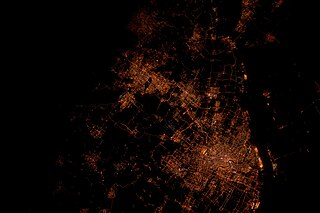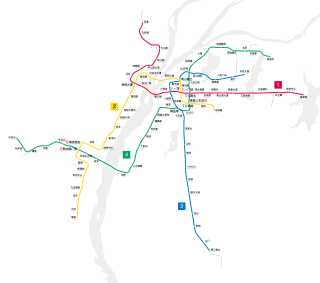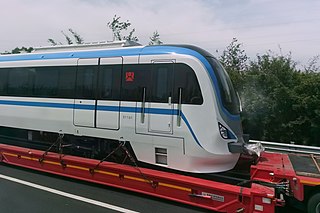
The Yangtze Delta or Yangtze River Delta is a triangle-shaped megalopolis generally comprising the Wu Chinese-speaking areas of Shanghai, southern Jiangsu, northern Zhejiang and northern Jiangxi. The area lies in the heart of the Jiangnan region, where the Yangtze River drains into the East China Sea. Having fertile soil, the Yangtze Delta abundantly produces grain, cotton, hemp and tea. In 2021, the Yangtze Delta had a GDP of approximately US$4.3 trillion, about the same size as Japan.

Huainan is a prefecture-level city with 3,033,528 inhabitants as of the 2020 census in north-central Anhui province, China. It is named for the Han-era Principality of Huainan. It borders the provincial capital of Hefei to the south, Lu'an to the southwest, Fuyang to the west, Bozhou to the northwest, Bengbu to the northeast and Chuzhou to the east. Huainan is one of the core cities of Hefei Metropolitan Circle and is known for its coal industry and thermal power plants. Its built-up area made of 4 urban districts and Fengtai County largely being urbanized, was home to 1,868,944 inhabitants as of 2020. Its city flower is the Chinese rose and its city tree is the Old-World Plane Tree. It is also considered to be the hometown and birthplace of tofu.
Yuanjiang is a county-level city in the Province of Hunan, China, it is under the administration of the prefecture-level city of Yiyang.

Qujing is a prefecture-level city in the east of Yunnan province, China, bordering Guizhou province to the east and the Guangxi Zhuang Autonomous Region to the southeast; thus, it was called "Key between Yunnan and Guizhou" (滇黔锁钥) and "Throat of Yunnan" (云南咽喉) in the past. It is part of the Central Yunnan Metropolitan Region plan (滇中城市群规划) in effect for 2016–49. Its administrative population is 6,047,000 according to a 2015 estimate, of whom, 1,408,500 reside in the metro area, which contains Qilin District, Zhanyi District and Malong District. During the 11th National Five-Year Plan period, the government of Qujing planned to develop the city into the "big city at the origin of the Pearl River" (珠江源大城市) in the following decades, including increasing the built-up urban area to past 100 km2 (39 sq mi) and the urban population to surpass 1 million by 2020, the second in Yunnan, after Kunming.

Yingcheng is a county-level city of about 600,000 inhabitants in Xiaogan, eastern Hubei province, People's Republic of China.

Hongjiang, formerly Qianyang County is a county-level city in Hunan Province, China, it is under the administration of the prefecture-level city of Huaihua.

Hanchuan is a county-level city in east-central Hubei province, People's Republic of China. It is under the administration of Xiaogan prefecture-level city. The city's urban area is located on the left bank of the Han River a few tens of kilometres upstream from Wuhan. However, the county-level city as an administrative unit also includes some land on the right bank of the river as well. The city has been served by the Hanchuan railway station on the Wuhan–Yichang railway. Hanchuan is a sister city of Martinez, California, United States.
Linxiang is a county-level city in Hunan province, China, it is under the administration of the prefecture-level city of Yueyang. Linxiang is located at the northeastern edge of Hunan province, on the southeastern (right) bank of the Yangtze River, which lies to the east of the city proper. Linxiang is bordered to the northwest and the north across the Yangtze by Jianli County and Honghu City of Hubei, to the east by Chibi City, Chongyang and Tongcheng Counties of Hubei, to the south and southwest by Yueyang County, to the west by Yunxi District. It covers an area of 1,718 km2 (663 sq mi), as of 2015, it had a registered population of 537,500. The city has 3 subdistricts and 10 towns under its jurisdiction. the government seat is Chang'an (长安街道).

Dongguan Rail Transit or Dongguan Metro is the rapid transit system of the city of Dongguan in Guangdong Province of China. It is operated by the state-owned Dongguan Rail Transit Corporation, Limited. The construction of the first section of Line 2 began on 26 March 2010, opening on 27 May 2016. Current plans call for some lines of the Dongguan Rail Transit to connect with the neighbouring Shenzhen Metro and Guangzhou Metro.
Longgan Lake is a freshwater lake in central China, divided between Susong County of Anhui Province and Huangmei County at the eastern extremity of Hubei Province. The lake is situated near the north bank of the middle reaches of Yangtze River, opposite Poyang Lake. The lake was named Longgan Lake in a 1955 decision which combined the names of two former lakes, Long Lake (龙湖) and Gan Lake (感湖).

Nanchang Metro, officially Nanchang Rail Transit, is a rapid transit system in Nanchang, Jiangxi, China. As of 2021, four lines are operational. The Metro opened for commercial operation in December 2015. The network is currently 128.3 km (79.7 mi) in length in December 2021 with 4 lines. A total length of 163 km (101.3 mi) of network is planned, with Line 5 which is currently under planning.

The Pearl River Delta Metropolitan Region Intercity Railway System is a regional higher-speed rail and suburban rail network being gradually constructed in the Pearl River Delta, People's Republic of China. The project's goal is to have every major urban center in the Greater Bay Area to be within one-hour travel by rail to Guangzhou. On March 16, 2005, the State Council approved plans for a regional high-speed commuter rail network for the Jingjinji, Yangtze River Delta and the Pearl River Delta. According to the plan, by 2020, the network will have a total route mileage of about 600 kilometres (370 mi). In September 2009, the plan was expanded to 1,478 km (918 mi) of routes split up into 23 lines. In the long term vision network length will reach 1,890 km (1,170 mi) by 2030. By then the network will provide basic coverage to the Pearl River Delta region. The Suishen ICR, Guanhui ICR and Guangfozhao ICR accept Alipay, avoiding the need to purchase tickets in advance.

Xiamen Metro, officially branded as AMTR, is a rapid transit system serving Xiamen, Fujian, China. Line 1 began operation on 31 December 2017. Line 2 began operation on 25 December 2019. Line 3 began operation on 25 June 2021.
Line 1 of the Dongguan Rail Transit,, is a rapid transit line under construction in Dongguan, Guangdong. Phase 1 of Line 1 connects Wanghong station in the North with Huangjiang Center station in the south.

Central Plains Metropolitan Region intercity railway system is a network of 14 regional high-speed railways radiating or surrounding the city of Zhengzhou, Henan province, China. It is a plan for the gradual implementation of a regional rail system across the province. The system involves Zhengzhou, Luoyang, Kaifeng, Xinxiang, Jiaozuo, Xuchang, Pingdingshan, Luohe and Jiyuan, it aims to form a convenient, fast, safe and efficient intercity rail transportation network. In September 2009, the National Development and Reform Commission produced the "Central Plains Metropolitan Intercity Rail Transit Network Plan (2009–2020)", calling for the planning and construction of approximately 496 km of the total mileage across the regional high speed transit network. The vision is for greater transport opportunities and ultimately the formation of Zhengzhou as the urban centre, with Luoyang as a secondary urban centre, after connecting the major urban areas in the Central Plains urban agglomeration.

Line 22 (Pinggu line) of the Beijing Subway is a rapid transit line under construction in Beijing and Hebei Province.

Shanghai Suburban Railway (上海市域铁路) is a network of regional railways radiating or surrounding the city of Shanghai, China. It is a plan for the gradual implementation of a regional rail system across the metropolitan area. The system will eventually connect with Jiangsu Yangtze MIR and Hangzhou Greater Bay Area network.

The Ministry of Natural Resources is an executive-department of the State Council of the People's Republic of China which is responsible for natural resources in the country. It is the 14th-ranking department of the State Council.

Taizhou Rail Transit, are two systems of commuter railway, one of which effectively works as a metro system in Taizhou, Zhejiang province, China. The system is operated by Taizhou Rail Transit Construction and Development Co., Ltd. In the near term, two lines, S1 and S2, are planned; in the long term, lines S3 and S4 are planned. The first phase of the plan was approved by the National Development and Reform Commission of the People's Republic of China in December 2014, and approved by the Zhejiang Provincial Development and Reform Commission in September 2016. Construction of Line S1 started in November 2016 and lasted until opening in December 2022.
Territorial spatial planning is the spatial planning system of the People's Republic of China which, according to its official definition, serves as the guide of the country's territory's development, the blueprint of sustainable development, as well as the fundamental basis of all kinds of development. Territorial spatial planning is an "all-in-one" planning encompassing former major function zone planning, land-use planning, urban and rural planning, as well as other different types of spatial planning.















